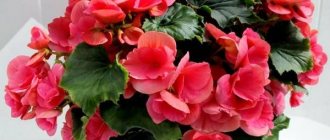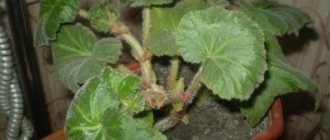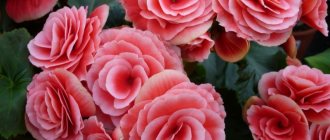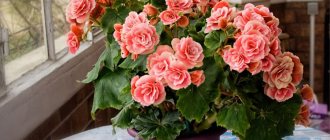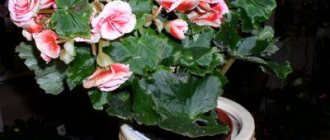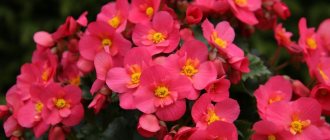Among other rhizome species, Tiger or Bauer begonia stands out due to its attractive appearance and easy care. It may not be as spectacular as the Royal one, but some gardeners like it even more than Mason or Imperial begonias. Unlike them, Bauer’s appearance is not capricious, it can stand on a refrigerator or any window sill, and in summer it will decorate a not too sunny balcony.
Botanical description
Bower's begonia (Begonia bowerae) is native to tropical Mexico and has several natural varieties and many cultivars. For some reason, in the post-Soviet space, the name Tiger has become synonymous with it, although only the pattern of naturally shaped leaves resembles the stripes. And even remotely, to see it, you need to turn on your imagination. Numerous cultivars are usually covered with expressive spots, more likely leopard than tiger.
In English-language sources, Bauer's begonia is often called “ciliated,” which more accurately describes its appearance.
What does a bush look like?
Bauer's species begonia is a rhizomatous, evergreen, perennial plant. It is grown in culture for its beautiful leaves, has several natural forms, many varieties and hybrids, including interspecific ones.
Tiger begonia reaches a height of 25-30 cm, diameter in a pot is 20-25 cm. When placed in wide containers, the creeping stem spreads over a large area. But usually bushes are planted this way only in botanical gardens to show the growth pattern of the crop.
Bauer's begonia is a rhizomatous species. Rhizome is a thick modified stem, covered with scars from fallen leaves, adventitious roots are fibrous, weak, located close to the surface.
Young shoots initially grow vertically or at a slight angle to the ground, but quickly take a horizontal position. Tiger Begonia stems droop when they extend beyond the pot. Without trimming, the flower turns into an ampel.
The culture is growing very quickly. In 2-3 years, with proper care, a small cutting turns into a lush bush, which becomes cramped on the windowsill.
Without pinching or pruning, there is usually only one growth point - at the end of the stem. To induce tillering, it is removed, dormant buds awaken on the rhizome, and new rosettes appear.
The culture is valued for its beautiful leaves. Compared to other rhizomatous begonias, the Bauer species is relatively small, the maximum length reaching 10 cm, width up to 4-6 cm.
The plates are located on petioles of medium thickness, which can grow straight up, bend or slope down. With insufficient lighting or improper care, they become very elongated, which does not always add decorative value to the bush.
The asymmetry of the plates of Bauer begonia is clearly visible, the shape is oblique-heart-shaped, the tip is sharp, elongated, the edge is serrated, with rare triangular protrusions. The petiole and edge are decorated with long hairs similar to eyelashes.
The underside of the leaf is light with reddish veins. The front side of young plates of Tiger Begonia is glossy, bright green; in mature ones it becomes emerald, matte. Along the edge there are dark chocolate spots that appear black. They are densely located, uneven, floating towards the center, which is why they look like an edging with transverse stripes.
The colors of the varieties and varieties are not radically different; Tiger begonia is unmistakably visible in the plants.
Bauer's begonia blooming
With proper care, the crop blooms annually. Typically, loose clusters with small white buds on long pinkish stems appear in late winter or early spring. They are unstable, can grow upward, bend or bend at any angle, and sometimes even fall down.
In terms of decorativeness, the corollas are significantly inferior to the foliage. In order not to deplete the bush, experienced indoor plant lovers break off flower stalks as soon as they appear.
Briefly about care
- Watering. The tropical crop is moisture-loving, so you need to systematically water the bush. In spring and summer, watering should be at least three to four times a week. In autumn and winter, the number of waterings can be reduced to two per week.
- Illumination. The hybrid plant needs sunlight, but the flower should be protected from direct sunlight, which can cause burns.
- Humidity. Tiger begonia prefers to be in moist air, but it is not advisable to spray the bush.
- Temperature conditions. In the summer, the air temperature should be 20–23 °C. In winter, the thermometer should not fall below 15–17 °C.
- Bloom. This tropical beauty blooms very rarely. Flowering occurs in the autumn-winter period. The inflorescences are small, light in color.
- Transfer. The plant needs to be replanted in the spring. Young specimens must be replanted every year. Adults - once every few years.
- Soil mixture. The soil composition should include humus, peat, coarse sand, and perlite. Be sure to take care of the drainage layer.
- Fertilizers. The crop needs to be fed in the spring and summer, no more than once a month.
- Reproduction. By seed, cuttings or dividing the bush.
- Diseases. Powdery mildew and gray rot.
- Pests. Scale insects, aphids, felt insects.
Natural varieties and varieties
Bauer's begonia has several varieties (ecological races). In culture there are:
- Begonia bowerae var. Major with smoothly colored shiny plates;
- B. bowerae var. nigramarga - a variety with small, rugged leaves that turn almost black with good care, and long “cilia” along the edges;
- bowerae var. Roseflora with pink flowers.
Among potted plants you can find a red-leaved natural form. It was found in an area geographically isolated from the main species – Begonia bowerae f. Rubra.
Of the varieties in popularity, the palm belongs to the Bauer Tiger begonia (Tiger). This is a beautiful plant, usually grown as an ampel. Reaches a height of 10 cm. The leaves are velvety, with long “cilia” along the serrated edge, similar to an oblique heart with a sharp tip.
Tiger
The coloring differs from the species, reminiscent of a leopard, not a tiger:
- yellowish-light green round or oval spots are located close to the edges;
- the main background is dark green, in intense lighting it is bronze.
The remaining Bauer varieties differ in the shape, location, color of the spots and the color of the main background - from yellowish through all shades of green to brown and purple. The size or degree of ruggedness of the leaves may vary. The corollas are white to pink, usually in pale shades.
Black Velvet
Popular varieties and hybrids of Bauer begonia:
- Cleopatra;
- Black Velvet;
- Apple Pie;
- Rhinestone Jeans;
- China Doll;
- Chantilly Leys;
- Vov-Arriola;
- Chaichi;
- Leprechaun;
- Persian Brocade;
- Kosmatka;
- Abu Dhabi;
- Apache;
- Bethlehem Star;
- Little Darling.
Bloom
Blooming tiger begonia
Flowering tiger begonia is a rare occurrence. Only an adult, healthy and well-groomed specimen is able to bloom at home. The plant blooms mainly in the autumn-winter period once a year. The white, small flowers look like the wings of moths. The flowers are similar in size, shape and color to the inflorescences of another variety - grassy begonia (begonia herbacea).
Tiger begonia flowers
To make flowering last longer, you can feed the bush with mineral fertilizers.
During the flowering period, you cannot move the pot from place to place or replant the crop.
Home care
Bauer's varieties and hybrids, compared to most rhizome begonias, are considered unpretentious and easy to care for. But this does not mean that the plant can be “planted and forgotten.”
Lighting and temperature
Tiger Begonia needs bright diffused light or light partial shade when caring for it at home. With a lack of lighting, the pattern on the leaves turns pale and the petioles become very elongated. In deep shade, the plant may die. But under direct rays, the plates get burned, dark spots lose contrast, and even with proper care, the bush seems lethargic.
Under artificial light, Bauer's begonia grows well. The main thing is that it is intense, and the duration does not exceed 12 hours a day - this is a plant of short daylight hours.
If the sun hits the flower from the side, the bush becomes deformed. Every week the pot is turned a quarter turn relative to the light source, and in order not to get confused when leaving, do this only clockwise or counterclockwise.
Tiger begonia loves cool weather, grows well at temperatures of 18-21° C. In winter, a decrease is possible, but not less than 15° C. Heat of 26° C or more leads to a stop in development, life processes freeze.
The plant loves frequent ventilation and can stand on a cool balcony in summer. It is not advisable to take it outside. Tiger Begonia should be protected from cold drafts.
Humidity and watering
Irrigation throughout the season is best done abundantly, but infrequently. The earth ball should dry out 1/3 or 1/2 between waterings. The soil that is wet on top should not be moistened even a little - the crop is prone to root rot, which must be taken into account when caring.
In winter, watering is reduced. But the earthen lump should not dry out completely.
Low humidity is more likely to lead to the loss of decorative properties of Tiger Begonia than to the death of the plant. Since you can’t spray the leaves, you can increase it in one of the following ways:
- place low, wide vessels with water nearby;
- place the pot on wet pebbles, expanded clay, sphagnum;
- in winter, hang a damp terry towel on the radiator;
- buy a household humidifier;
- spray several times a day around the plant so that the liquid does not get on the leaves.
In the cold season, if the room is hot, air humidity must be monitored especially carefully. With a cool wintering of Bauer begonia, on the contrary, you can forget about this.
The water should not contain chlorine, be soft, and the temperature should be several degrees higher than in the room. Tap or hard well:
- filter;
- frozen;
- defend;
- boil.
Feeding
When caring for Tiger Begonia, use chlorine-free fertilizers for decorative foliage plants. They are used from spring to early autumn every 2-3 weeks, on wet soil.
In the cold season, feeding is stopped. Only first-year plants grown from leaves are given a half dose of fertilizer once a month during the first winter.
Trimming
Over time, rhizome begonias, including Bauer's and Tiger's begonias, lose their stems. This is a natural process; even with ideal care, the leaves live no more than 3 years, then they fall off.
As long as the indoor flower looks good, the bush can be left alone, especially if it is dense, and the bare bases of the shoots are covered by leafy branches. Sometimes the owners themselves carefully bend and hide the “bald” stems when leaving.
To maintain decorativeness, pruning is carried out, leaving a column of about 5 cm. Soon the sleeping buds will awaken on it, Tiger Begonia will begin to actively bush, sprout new rosettes and leaves.
The cut shoot is allowed to propagate by cuttings.
This is also a rejuvenation of the bush. Experienced gardeners usually do the following:
- All old stems on one half of the Bauer begonia are cut off.
- The exposed side is unfolded so that it is not conspicuous. In about a month it will grow well and become attractive.
- Tidy up the second half of the bush.
The care package must include the timely removal of worn-out plates: they not only spoil the appearance, but can rot.
It is better to break off the stems with buds immediately - flowering greatly depletes the plant. Bauer's begonia will require attention and additional feeding, and the good thing about the culture is that it is beautiful with minimal care.
Pests and diseases of begonia
Aphids grow on stems and peduncles and feed on the sap of the plant, causing harm to it. In addition, it can become a carrier of viruses. You can remove insects manually, but after that you must treat them with a soap solution. Laundry soap can be replaced with shag (infuse 100 g of shag in a liter of water for 2 days). If the aphid has settled for a long time, it is better to use insecticidal preparations.
The presence of fluffy lumps on the leaves indicates the presence of felt insects. To combat parasites, a solution of insecticide with water is used. After wetting a cloth or cotton wool, wipe the plant thoroughly. If felt bugs appear again, treat with undiluted preparation.
The causative agent of gray rot is a fungus from the genus Botrytis. Fungal spores move freely through the air, especially in high humidity. Gray spots form on the leaves and shoots, which subsequently turn into gray rot.
To combat, Bordeaux mixture with a concentration of 1%, which needs to be sprayed on the plant. Let's use another solution: dilute 2 g of copper sulfate in a liter of water. The latter can be replaced with laundry soap (20 g).
Lack of care also affects the appearance of the plant. Begonia should be watered carefully, but if watering is insufficient, the leaves and buds will fall off. The lack of light will also be indicated by leaves that will fade and turn pale.
Bauer's begonia is relatively unpretentious and not capricious to care for. Feels great when transplanted. With a little attention, your home will be decorated with one of the most beautiful representatives of the begonia family.
Transfer
All begonias love moving into fresh substrate, Tiger begonia is no exception. At the same time, it is not necessary to do a complete transplant, and is not even recommended if everything is in order with the root system. Every spring:
- Take a flower out of a pot.
- Lightly knead the surface of the earthen clod.
- About 1/3 of the old soil is removed.
- Drainage is poured into a new container. It should occupy at least 1/5 of the volume.
- Straighten the roots and transfer the begonia to fresh substrate.
- Watered.
- Place in a shaded, cool place for 2-3 days. Then they take care as usual.
The pot for Tiger Begonia should be wide and low - the root of the culture is superficial. If you take a container of a regular shape, fill the “excess” space with drainage.
Every year the diameter is increased by 2-3 cm. When the bush ages, a bald spot will appear in the center, the soil must be completely removed, and the rhizome divided into parts. You will get several new begonias.
The main thing when choosing a pot is the presence of drainage holes.
The substrate can be bought in the store, based on peat, for ornamental foliage plants. Specialized “Begonia” is not suitable for Bauer varieties; beautiful flowering varieties develop well in it.
Signs and superstitions
Tiger begonia has long settled in the houses and apartments of flower growers, and not only. This plant has acquired various superstitions:
- believed to bring happiness to the family;
- helps lonely people find love;
- attracts money to the house;
- capable of predicting the future: if the plant withers, this is a bad omen;
- a fast-growing, healthy begonia indicates good luck and prosperity in the home;
- unexpectedly appearing flowers on a plant are a sign of an upcoming addition to the family.
Check out these indoor plants: red leaf begonia, cleopatra begonia, mason begonia, coral begonia and evergreen begonia.
Bauer will be a wonderful decoration for any home. This original flower will not take up much space on the windowsill, will not require careful care, and can also bring good luck and prosperity (if you believe the signs).
Reproduction methods
Tiger begonia is easy to propagate vegetatively:
- Whole leaves, their fragments and “lying”, with notches across the thick veins.
- By cutting the shoots remaining after pruning.
- By dividing the rhizome when rejuvenating an old bush.
Root stem and leaf cuttings:
- in water;
- perlite;
- peat;
- light substrate.
The rhizomes of Tiger Begonia are divided into parts, dried, and germinated in low, wide bowls with drainage holes filled with peat and sand. Place on the surface of the substrate, press lightly, cover with transparent cellophane. Soon the sleeping buds will wake up, new leaves and rosettes will appear.
Amateurs usually do not propagate Bauer begonia from seeds.
Watering
Bauer's tiger begonia loves moisture, so you need to monitor the frequency of watering. During the hot season, you need to water the flower as often as possible, without allowing the soil to dry out. If in summer watering must be done every other day, then in winter the number of waterings should be reduced to twice a week.
Watering should be done correctly, directing the stream of water to the very roots. It is unacceptable for moisture to get on the spotted leaves. Excessive humidity can cause various fungal diseases and rot.
After watering, it is recommended to loosen the soil so that water does not stagnate on the surface. Loosening is especially useful for the root system, since the rhizome needs air and moisture.
The photo shows how to properly water begonia.
Important! Water the begonia bush with water at room temperature. The water must be soft, settled or filtered. If possible, you can irrigate with rain or melt water.
Problems during cultivation
The culture is healthy, infectious diseases are rare. Most of the troubles are associated with improper care:
- leaves curl due to cold or pests;
- due to excessive watering, the roots and above-ground vegetative organs rot when water gets on them;
- leaves may fall off in high humidity and low temperatures;
- lack of nutrition slows down growth;
- from the bright sun the tiger pattern becomes unclear;
- lack of light causes the petioles to stretch and the plates to turn pale;
- The edges turn black and dry out when watered with hard water.
Pests of Tiger Begonia:
- spider mite;
- mealybugs;
- scale insects;
- thrips.
Fungicides help control diseases, and insecticides are used to eradicate pests. When fighting spider mites, drugs must have an acaricidal effect.
Pests: ways to combat them
Tiger begonia is affected by aphids, red spider mites, nematodes and weevils.
- Aphids are small insects that suck juice from soft tissues. Prefers to attack the tips of shoots, leaves and buds. Control methods: spray with permethrin-containing preparations or derris.
- The red spider mite is a small sucking insect that affects the lower part of the leaf, and yellow spots form on the upper side of the leaf. A web forms between the stem and leaves. Over time, the affected leaves fall off. Control methods: spray the plant with a systemic insecticide or derris.
- A nematode is a microscopic worm that attacks the root system. A plant infected with a nematode cannot be restored. The plant is destroyed.
- Weevils are larvae up to 2 cm long that settle in the soil substrate. They feed on the sap of the root system. It is difficult to fight the pest; it very quickly destroys the root system. Control method: treat the soil with an insecticide; if the plant does not recover, it should be destroyed.
The cause of plant death can also be decomposition of the roots due to normal waterlogging of the soil. If you remove the plant from the container and examine the root system, you can determine the true cause of the death of the plant. If there are swellings on the roots, it is a nematode. If the tubers are eaten away, it is a weevil. If the root system is decrepit with the smell of rot, this means that the soil is severely waterlogged.
What problems might arise?
When growing begonias from cuttings, some problems may arise.
If roots don't appear
For them to arise, the following rules must be observed. It is worth refreshing the cut on the cutting, which is in the liquid, and pouring clean water. You can also add Kornevin to the liquid. It is necessary to check the dryness of the soil; if the soil is dry, then you need to cover the cutting to obtain high humidity. It is necessary to periodically change the method of soaking cuttings in liquid to the method of rooting cuttings in the soil. You can't rush, you need to give the flower time.
If the flower does not develop
We need to inspect the plant. Due to poor care, diseases and pests can appear. Diseases can be cured with the help of special medications, but harmful insects must be removed yourself or use systemic insecticides. It happens that the flower is too filled with liquid. If the plant is lethargic, then you need to remove the soil from the pot to dry it. It is necessary to replace the soil and trim rotten roots. Then you need to put the begonia back in the container.
If the flower does not develop with the onset of winter, then it should be left until spring. In spring, begonia will continue to develop. In summer, the plant needs to be transplanted outside to make it healthier.
It is important that the room where the begonia will be planted is protected from winds, showers and hot sun. Thus, this flower is very easy to care for, it is easy to cut and grow.
If the cuttings cannot take root, then they need to be planted again.
For information on how to propagate begonia from cuttings, see below.
Features for some types: how to form?
- Red leaf begonia. The purpose of pruning is to obtain planting material. It is not recommended to form its crown.
- Elatior, a beautiful flowering hybrid. After the flowering period, this species loses its attractiveness; this is corrected by pruning. To do this, leave stumps 5-7 cm tall. New shoots that grow are pinched to form a bush with dense foliage.
- Terry begonia, ever-blooming variety. It grows intensively, the stems quickly stretch, so regular pruning is required. Thanks to this, the plant actively blooms and looks impressive.
- Coral begonia, bush variety. A special feature of caring for this species is its formation in the form of a bush. Therefore, to form side stems, it must be pinched periodically.
- Masona, decorative deciduous variety. In order for this type of flower to begin to bush, it needs to be pinched, setting the desired shape.
- Hogweed. During growth, the plant becomes longer and the lower part of the stem becomes bare, so the elongated shoots are cut off, leaving small stumps, from which new foliage will later appear.
- Cleopatra, decorative flowering plant. This species is pruned in the spring or when replanting, leaving about 5 cm of stem.
- Tiger begonia, ampelous tuberous variety. When transplanting, the leaves are cut off for successful rooting. A young plant up to 4 years old is replanted every spring.
- Spotted begonia, decorative deciduous variety. The top of the species is pinched to form a lush crown. To increase the size of the leaves, the buds are cut off. Old plants are rejuvenated by pruning every 3-4 years.
- Collared begonia, ornamental flowering plant. Trim it to form a beautiful crown. The top shoots are removed to allow the side stems to grow. This is usually done in the spring.
Rooting in water
Planting leaves without roots has one significant disadvantage: the lower part is hidden by the ground, and therefore it is not always possible to notice the appearance of rot in time. Usually some of the seedlings die precisely for this reason. To be on the safe side, you can root the leaf in water and then place it in the ground: there will be a greater chance of success.
- You need clean boiled water and cooled to room temperature. To speed up the process and disinfect, you can add a little stimulant, charcoal or activated carbon.
- Water must be poured into a suitable sized plastic or glass container. Place the leaf in it so that it does not fall through and only its stem touches the water.
- It is better to cover the container on top with a transparent plastic cap, which can be made from a bottle or plastic bag.
- After the roots appear, the cap is finally removed, and you can plan to transplant into the ground.
Rooting in water usually takes up to 2 weeks. In dark glass, roots appear literally in a matter of days, but it makes diagnosis difficult. If signs of rotting appear on the roots or leaves while in water, you need to take immediate action:
- Wash the glass, boil it and pour fresh water;
- remove all damaged areas from the seedling;
- Sprinkle the cuts with charcoal and air dry for a couple of hours.
If everything was done on time, the sheet will be saved.
Use in landscape design
Tiger begonia is used to decorate the room. It can be placed in a cool place protected from the wind, for example on a balcony or terrace. In a room on a shelf it will look like a colorful living decor. The plant, with its wide leaf blades, collects dust and humidifies the air in the room. The popularity of tiger begonia is growing from year to year. This is due to its unpretentiousness and beautiful appearance.
Growing from seeds
Indoor begonia (care, cultivation, propagation and pruning - we will consider all this later) can propagate by seeds. Anyone can simply come to a flower lovers store, buy a bag of begonia seeds that they like better in appearance, and plant it at home! If you grow begonias from seeds, caring for and growing them at home will have its advantages: you plant the seeds, some will germinate, others will not, choose the strongest sprouts, give the rest to friends, or simply dispose of them. Planting seeds is much cheaper than buying a ready-made plant, and even those brought from stores have difficulty taking root in a new place (either the care is not right, or you don’t like the place, but 9 and 10 plants bought in the store die).
- Prepare the ground. It should be a mixture of two parts: one part is black soil, the second is a mixture of fine sand and peat.
- Begonia seeds are very small, so you will have to work with tweezers.
- Place the seeds in water with manganese (a weak, barely pink solution) for several hours. Next, place them on a paper towel.
- Fill the container with prepared soil, place the seeds 2-3 centimeters apart to a depth of 1 centimeter.
- Moisten the soil carefully, in separate droplets, so as not to bury the seeds even deeper.
- Cover the container with cellophane or glass and place in a cool place. Don't forget to moisten the soil!
- Shoots should appear within 5-20 days. As soon as the third leaf breaks through, you will need to pick! The second diving procedure is also necessary; it is carried out at the time of transplanting the plants into permanent pots.
Next, follow the care rules when growing begonias. Ampel and simple types need the same procedures!
Transplanting into a new pot and rejuvenating the bush
Tiger begonia is a perennial plant, and also has the form of a lush, spreading bush. It is clear that if the rules of care are followed, it grows very quickly and needs constant replanting.
The young bush is replanted every spring until it is 3-4 years old. But a plant older than this age is replanted every 2 years. The basic principle is that each new pot is chosen 4-5 cm larger in diameter than the previous one.
Transplanting a Bauer begonia into a new pot is not that difficult. Visual video instructions will help with this.
Rejuvenation of the bush should be carried out only on adult, mature plants (over 4 years old). To do this, you should completely cut off old, weak leaves, as well as flower buds, which take away quite a lot of moisture and nutrients. If necessary, healthy foliage is also cut off, which clearly spoils the appearance - for example, it protrudes too far beyond the main contour of the bush.
Why do you need to form a crown of indoor flowers?
Among the main goals of plant formation are:
- Limiting the space that the plant occupies;
- Giving the desired shape and attractive appearance;
- Removing ugly, weak shoots;
- Providing access to light and air to the flower;
- Stimulating flowering by reducing the number of shoots and branches that deplete the plant;
- Ensuring equal development of all shoots, uniform distribution of nutrients between them;
- Stimulating the development of shoots that will produce flower buds.
The main techniques for forming the crown of indoor plants are pruning, pinching, pinching and tying.
Cuttings from Bauer's begonia
Tiger begonia can be propagated by cuttings at any time in spring and summer. To do this, you need to take a healthy leaf from an adult plant with a 5-centimeter piece of a leaf cutting and embed it halfway into soil consisting of a mixture of perlite, wet peat and coarse sand, taken in equal parts. The pot should be placed in a plastic bag with holes for ventilation and placed in a room where the temperature is at least 17 degrees C. The leaf cuttings can be planted in a small pot with a diameter of 7 cm, or several pieces of Bauer begonia cuttings can be placed in a larger pot.
In a month or a month and a half, young shoots emerging from the cuttings will see the light. And after another month, young plants can be planted in separate pots. It will be better if each plant has its own pot.
The benefits and harms of indoor plants
Every living creature on the planet has a certain energy.
Let's figure out what begonia is and what its character is:
- The plant is often placed in offices and studies; it is believed that it promotes relaxation and relieves stress.
- Another important property: begonia eliminates anxiety and restlessness, increasing performance. This makes it indispensable: place a flower on your desktop.
- The variegated flower has a good character, its presence helps relieve tension and improve mood. It will facilitate complex business negotiations and help family members find a common language.
- Begonia decoction is used to treat alcoholism. It causes aversion to alcohol. Secret treatment is possible when a person is dosed with a decoction in their drinks. But it is better not to experiment, but to test for a possible allergic reaction and treat the disease openly, with the permission of the patient.
- Experts believe that the plant works like an energy air conditioner. It passes energy through itself, releasing only positive energy. Negative - the plant feeds by absorbing it along with carbon dioxide.
- The flower is useful for melancholic, sensitive and vulnerable people. It is good to give it to a person suffering from an emotional or mental disorder. It resists the development of depression by drawing out all the negativity. You can simply place a depressed person in a room full of flowers of this variety for a day, the result will pleasantly surprise you.
Useful video
Can it be kept in open ground?
Begonia everblooming is often used in outdoor landscaping - in flower beds and containers. In warm regions, this is an evergreen begonia - a perennial. In temperate climates, it is grown as an annual.
It is recommended to plant seedlings outside after all frosts. In May, you can take containers with seedlings into the greenhouse. During the day, in warm weather, the plants are opened slightly for hardening.
Begonia everblooming in a flower garden
7-10 days before transplanting into open ground, begonia is fertilized with potassium phosphate 5 g per bucket of water. After planting, you can treat it with epin or zircon.
Plants outside need to be weeded, loosened or mulched, watered and fed. For mulch, use leaf compost, humus or peat. Feed with complex fertilizers.
In the fall, healthy, strong begonias are transplanted into pots and taken home from the garden. When the plants adapt indoors, they will begin to bloom again.
Begonia everblooming grows well both indoors and in the garden. It is easy to grow for beginners and interesting to collect for experienced gardeners.
Anti-aging pruning
Some plants, especially those that grow slowly, can do without rejuvenation. But most indoor green “friends” still have to be pruned for this purpose. For example, these are flowers that quickly stretch out when there is a lack of light. Plants with long shoots especially need this type of pruning.
Over time, due to lack of light, too high a temperature or insufficient air humidity, their leaves at the base dry out and fall off. And the flower takes on an unattractive appearance. These are, for example, tradescantia, balsam, passionflower, abutilon, pelargonium, dieffenbachia. Their lower part quickly becomes exposed, and the only way to maintain a well-groomed and attractive appearance is to trim them regularly and thoroughly.
Anti-aging pruning is best done in the spring before or shortly after the growth period, or in the fall, when the plant is dormant (you can read more about the life phases of indoor plants here).
Shoots are cut almost to the ground
It is important that there are 2-4 living buds left on the “stump”. Only 10-15% of the entire flower may remain
However, the more thorough the pruning, the more vigorously new shoots will grow. If it’s hard to decide to trim the entire plant at once, you can do it in 2 stages. First, half of the shoots are cut off. And when new ones grow from them, the remaining half is cut off.
After rejuvenating pruning, the flower needs feeding, because it will undergo intensive growth.
Watering at this time is slightly reduced, because the shortened upper part does not need a lot of moisture. It is better to place the pot in partial shade, away from direct rays of the sun. After such pruning, the flower produces many healthy, strong shoots and acquires a luxurious appearance.
Instructions: how and where to plant?
Since Begonia Bauer is of southern origin, it is very demanding in terms of conditions:
- The flower needs to create an analogue of the conditions of the area where its history begins. Namely: high temperature (more than 20 degrees Celsius) and high humidity.
- There is an opinion that the plant can adapt to any living conditions, but ideally a warm and humid climate is best for begonias.
- Begonia does not accept all plants equally well as neighbors. She feels great next to Lobelia, Balsam, Nemesia.
Bauer's begonia, which grows in a cool room, requires sparing watering.
Lighting and location
Begonia is not recommended to be grown either in bright sun or in a heavily shaded place . If bright light falls on the flower, this may negatively affect the color of the petals, but at the same time the number of flowers will increase significantly. Therefore, light. Falling on a plant must be scattered.
The ideal place is southeast or southwest windows. If you want to place a flower on a south window, you will have to create a shadow for it.
Begonia grows well on the balcony . If you want to keep it in the country, then a bright and cool place, protected from the wind, will be most suitable for this purpose.
Soil requirements
Begonia will feel great and grow well in fertile soil. You can buy soil in specialized stores or prepare it yourself. To do this, you need to mix leaf soil, sea sand, moistened peat, humus, coniferous or turf soil in equal proportions. You also need to monitor the acidity of the soil. This indicator should be between 5.5 and 6.5 pH.
Important : When planting a plant, you need to ensure that peat does not get on the roots. Otherwise, the ornamental plant will die from severe burns.
